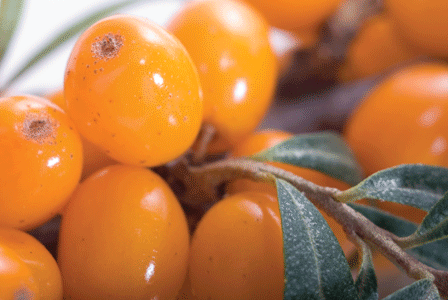
In North America sea buckthorn is known for its nutrient-packed leaves of berry-goodness. The plant is also a rich source of antioxidants and vitamin C.
In North America sea buckthorn (Hippophae rhamnoides L.) is known for its nutrient-packed leaves and berries. The exceptionally thorny plant with origins in Nepal is a rich source of antioxidants, natural sugars, fatty acids, vitamin A, E, and B2, and minerals such as potassium and iron. It’s especially high in vitamin C.
With its motherlode of nutrients, sea buckthorn is a star ingredient in a host of natural health products. It can be found in the form of oil caplets, teas, and cremes formulated to keep skin healthy and to manage conditions such as acne, rosacea, and eczema. Quality products containing sea buckthorn are readily available at your favourite natural health retailer.
As an ingredient in food products, sea buckthorn is not as easy to find. In Europe and Asia it is cooked into fruity spreads, syrups, sports drinks, and even liqueurs. In Canada edible sea buckthorn products are extremely hard to find, whether fresh, frozen, or preserved.
There is a movement afoot, however, to bring sea buckthorn to Canadian tables, and it seems to be starting with some pioneering farmers.
Sisters are growing it for themselves
Last year Marlene Wynnyk harvested 5,000 pounds of sea buckthorn berries on her 6-acre orchard near Wingham, Ontario. Some of the fruit from that crop went to nearby culinary schools and was sold at local farmers’ markets. Some was turned into juice or stewed up for jams and salsas by Wynnyk’s sister, Sandra Rae.
The sisters make a powerful team. Wynnyk concentrates on the science of cultivating sea buckthorn, collaborating on research with the University of Guelph and the University of Western Ontario. Along with neighbouring Everspring Farms, Wynnyk’s Healing Arc Golden Orchard won a 2009 Premier’s Award for Innovative Agri-Food Excellence for Bruce Country.
Product development
While her sister is busy with the agricultural end of things, Sandra Rae develops recipes and makes products with the fresh sea buckthorn berries. Over the years she has experimented and refined her recipes, so that now her sea buckthorn juice, jams, and salsas are in high demand. Last year she sold 700 jars of jam and believes she could have sold many more.
“They have an amazing citrus taste,” says Rae about sea buckthorn berries. She points out that while lemons, limes, and oranges don’t readily grow in our Canadian climate, we can easily grow sea buckthorn for our own locally produced hit of citrus taste.
Tricks of the trade
In the eight years they’ve been growing sea buckthorn, the sisters have learned a few tricks. They’ve come up with an ingenious method for collecting the sea buckthorn berries from the notoriously thorny branches. At harvest the sisters, along with a crew of 20, trim the berry-laden branches, and with berries still firmly attached, package them in boxes.
A refrigerated truck then transports the boxes to a nearby facility to be flash-frozen. The berries, once frozen, easily shake free of the branches without being damaged.
The sea buckthorn orchard is a labour of love for the two sisters. They say they are at an age when they are not interested in marketing sea buckthorn products on a large scale. Instead they focus on their small operation and on producing quality products. Their hope is to show what’s possible with the nutrient-rich plant.
Sandra Rae’s Fresh Sea Buckthorn Salsa
Sea buckthorn berries are notoriously difficult to find in Canada. If you’re lucky enough to get some, try this delicous salsa.
1 cup (250 mL) mild onion, diced
1 cup (250 mL) green pepper, diced
1 cup (250 mL) red pepper, diced
1 jalapeno pepper, diced
2 Tbsp (30 mL) extra-virgin olive oil
2 cups (500 mL) tomato, diced
2 cups (500 mL) sea buckthorn berries
Zest and juice of 1 lime
Pinch of salt 1/2 cup (125 mL) cilantro, chopped
In medium saucepan gently saute onions and peppers in olive oil; just until limp.
Turn off heat; add tomatoes, sea buckthorn berries, zest and juice of lime, salt, and cilantro.
Serve with nacho chips or spoon over grilled fish, chicken, or tofu steaks.
Sea buckthorn saves
The uses of sea buckthorn seem to be endless—from skin-nourishing balms and supplements to tasty jellies and jams. Now food scientists are exploring the use of the tart little berry as a meat preservative. In a 2007 study from the Estonian University of Life Sciences, sea buckthorn was ground into a pulp and added to meat. Not only did the scientists find that meat treated with sea buckthorn spoiled less quickly, but it also contained healthy antioxidants imparted by the plant.
Sea buckthorn’s ability to keep food fresh is a welcome development. It comes at a time when we are beginning to realize that traditional food preservatives are adding some pretty scary spice to our perishables.
The Environmental Working Group (EWG) points to two preservatives, butylated hydroxytoluene (BHT) and butylhydroxyanisole (BHA), that have particularly unsavoury side effects, including liver and kidney damage. Sea buckthorn may prove to be a safer alternative that we can all enjoy.

